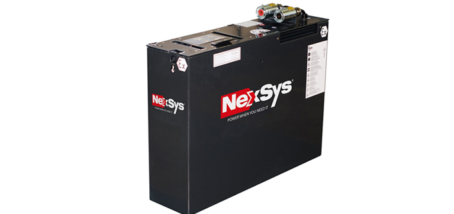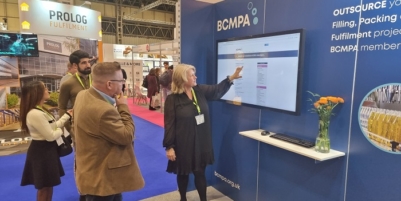-
ROSSLARE EUROPORT TARGETS HEALTH & SAFETY WITH CAMERA TELEMATICS PARTNERSHIP - 2 days ago
-
Landmark Study Reveals Wearable Robotics Significantly Boost Safety and Efficiency in Industrial Environments - July 24, 2024
-
Visku Tackle The Retail Seasonality Challenge One Pallet At A Time - July 22, 2024
-
KAMMAC AND BERGEN LOGISTICS STRENGTHEN FASHION & LIFESTYLE SERVICES IN THE UK - July 19, 2024
-
TENTBOX EXTENDS PARTNERSHIP WITH ARROWXL TO SUPPORT INCREASING DEMAND - July 17, 2024
-
The Perfume Shop improves customer journeys while driving profitability in partnership with Scurri - July 17, 2024
-
ZEROMISSION SECURES £2.3M ($3M) INVESTMENT TO ACCELERATE ELECTRIC FLEETS - July 16, 2024
-
BCMPA CELEBRATES SUCCESS OF 2024 CONFERENCE - July 15, 2024
-
Best of the Best: Jungheinrich Celebrates Triple International Award Win - July 12, 2024
-
GOPLASTICPALLETS.COM CALLS ON NEW CHANCELLOR RACHEL REEVES TO CONSIDER PLASTIC PACKAGING TAX REFORM - July 10, 2024
NexSys ATEX batteries bring advantages of Thin Plate Pure Lead (TPPL) technology to materials handling vehicles operating in hazardous areas
NexSys ATEX batteries, available from EnerSys, allow materials handling vehicles to work safely in hazardous areas where there is an explosion risk. They conform to ATEX standards, which are compulsory and a legal requirement in Europe and NexSys batteries are also available world-wide certified in compliance with IECx standards. The new batteries, available in nearly all DIN sizes and capacities, offer significant advantages over both Valve Regulated Lead Acid (VRLA) gel and flooded lead-acid solutions. These advantages result from the Thin Plate Pure Lead (TPPL) technology used in the batteries’ construction. Accordingly, they offer outstanding Amp-hour (Ah) capacity.
NexSys ATEX batteries require much lower maintenance than flooded types, with no need for topping-up. Critically for hazardous environments, the batteries’ electrolytes are non-spillable, as they are absorbed into the Absorbent Glass Mat (AGM) separator material. They also recharge faster than gel and flooded batteries, with opportunity charging being possible. This increases productivity and reduces costs. Additionally, service life is longer than for gel batteries.
The term ‘ATEX’, derived from the French ‘ATmosphères EXplosives’, applies to atmospheres made potentially explosive by the possible presence of dust or gases likely to ignite or explode, for example in oil and gas, mining and chemicals industries during handling and logistics operations. ATEX product certification verifies the design specification of a manufacturer’s product to a series of relevant standards. The certification process includes testing and assessment of the product, with ATEX and IECEx certificates and reports being issued for conforming product.
The NexSys batteries’ ATEX certification was granted by CSA Group SIRA, which is an independent body. SIRA certificate number 01ATEX3022X relates to the complete batteries, while 03ATEX3090U applies to individual cells. It is also available the certification in compliance with IECEx standard– with certificate number IECEx SIR 07.0065X for battery and certificate number IECEx SIR 07.0064U for cells. The company’s technical know-how and experience result from many years spent supplying various ATEX battery product ranges to explosion protection solution specialists, material handling equipment manufacturers and other customers.
The battery products and process fulfil ATEX Directive 2014/34/EU, with the production process being externally audited at regular intervals to ATEX standards. The batteries are designed for use in ATEX Zones 1 and 2 (Gases) as well as 21 and 22 (Gas and Dust) and Mining. Each battery is engineered to specific customer requirements. These include specially designed trays and lids for Zone 1 and increased protection and testing for zone 21 and 22 batteries. While Zone 2 product does differ from standard batteries, lids are typically not fitted, as cover protection is usually provided by the equipment/application. Additionally, ATEX-certified plugs can be supplied and installed on request.
The main issue with the special trays is the loss of capacity due to the different fit form. NexSys batteries, with its higher energy density solves this problem. TPPL plate thickness down to 0.8mm (3x more plates than gel and flooded in same volume) provide an higher energy density and a greater Ah capacity than a VRLA gel battery of the same physical size, together with greater or equal Ah capacity than a flooded battery of the same physical size. NexSys ATEX batteries can provide 10% more energy and power than standard flooded products and 15% more than standard gel products.
The batteries can be used over a temperature range of 0°C to 40°C, in low and normal duty applications working six days a week. Up to eight hours or more utilisation may be achieved, with a depth of discharge (DoD) to 80 per cent of C5, if recharge times are met. Cycle life can be improved by reducing DoD.
The batteries can be charged using NexSys or NexSys+, efficient modular high-frequency chargers. Charging time from 20 per cent state of charge to full charge is typically 6.25 hours or faster.
“In NexSys ATEX batteries, we have a solution that combines many benefits of flooded and VRLA gel batteries”, comments Mattia Bianconi, Application Manager Motive Power EMEA at EnerSys, “and this is based on our standard NexSys batteries, which have proven to be a product of choice in regular motive power applications since 2011. The ATEX batteries extend the same advantages, and product confidence, to users in hazardous environments. These are found in many sectors, from mining and tunnelling, chemical and pharmaceutical plants, oil and gas, military and aviation, to food and drink, waste management, printing and paper and many others.”

































